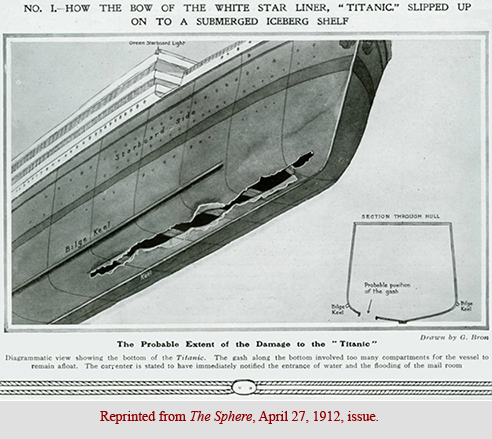
| Titanic |
| Home | Early Beginning | Life during the Luxury | Catastrophic End | For More Information |
The End of the Titanic
After the RMS Titanic departed from the ports in Southampton, England on April 10, 1912, it continued to sail into the Atlantic Ocean while accommodating its 3,300 passengers. It brought lavish lifestyles to its passengers from the First and Second Classes while packed the passengers from the Third Class ticket below deck. The Titanic travelled in full speed while on its way to bring a new life to its passengers in New York. But on April 14, 1912 at around 11:40pm, the ship hit an iceberg. With only 30 seconds left to stir the ship away from the iceberg after the lookouts spotted the big block of ice, the captain ordered the ship’s engine to be reversed and to make a sharp turn to the left in order to avoid the iceberg. As the ship passed the ice, the crew felt relieved because the ship only gathered a few ice on its deck. However, the crew was not aware of the 300-foot gash that Titanic endured from below.

“Suddenly a queer quivering ran under me, apparently the whole length of the ship. Startled by the very strangeness of the shivering motion, I sprang to the floor. With too perfect a trust in that mighty vessel I again lay down. Some one knocked at my door, and the voice of a friend said: 'Come quickly to my cabin; an iceberg has just passed our window; I know we have just struck one.” - Elizabeth Shutes, a forty-year old governess of a family from the First Class cabin.
After getting a 300-foot gash from the bottom part of the ice, the ship’s succeeding compartments were quickly filled with ice-cold water. This caused the bow of the ship to sink and it’s stern to be raised. The Titanic broke in half soon after. With only a few hours left to stay afloat, the captain of the ship, Captain Smith, ordered the ship's 20 lifeboats to be filled with "women and children first.” The number of lifeboats on board Titanic was not enough to save all of its passengers. In fact, it was only enough to save 1/3 of all of Titanic’s passengers. The reason why only a few lifeboats were on board the Titanic was because the lifeboats took up a lot of deck space and it was thought that lifeboats were unnecessary due to the idea that Titanic was “unsinkable.”
After staying afloat for hours, the Titanic sank at 2:20am on April 15, 1912. The survivors stayed in their lifeboats until the Cunard liner Carpathia came in to save them. The tragedy brought changes in travelling through seas. The first international Convention for Safety of Life at Sea was held in 1913. It was ordered that ships must have enough lifeboats for everyone on board and lifeboat drills must be held. The International Ice Patrol was established in order to monitor the icebergs found at the Atlantic Ocean. Also, ships were required to maintain a 24-hour radio watch.